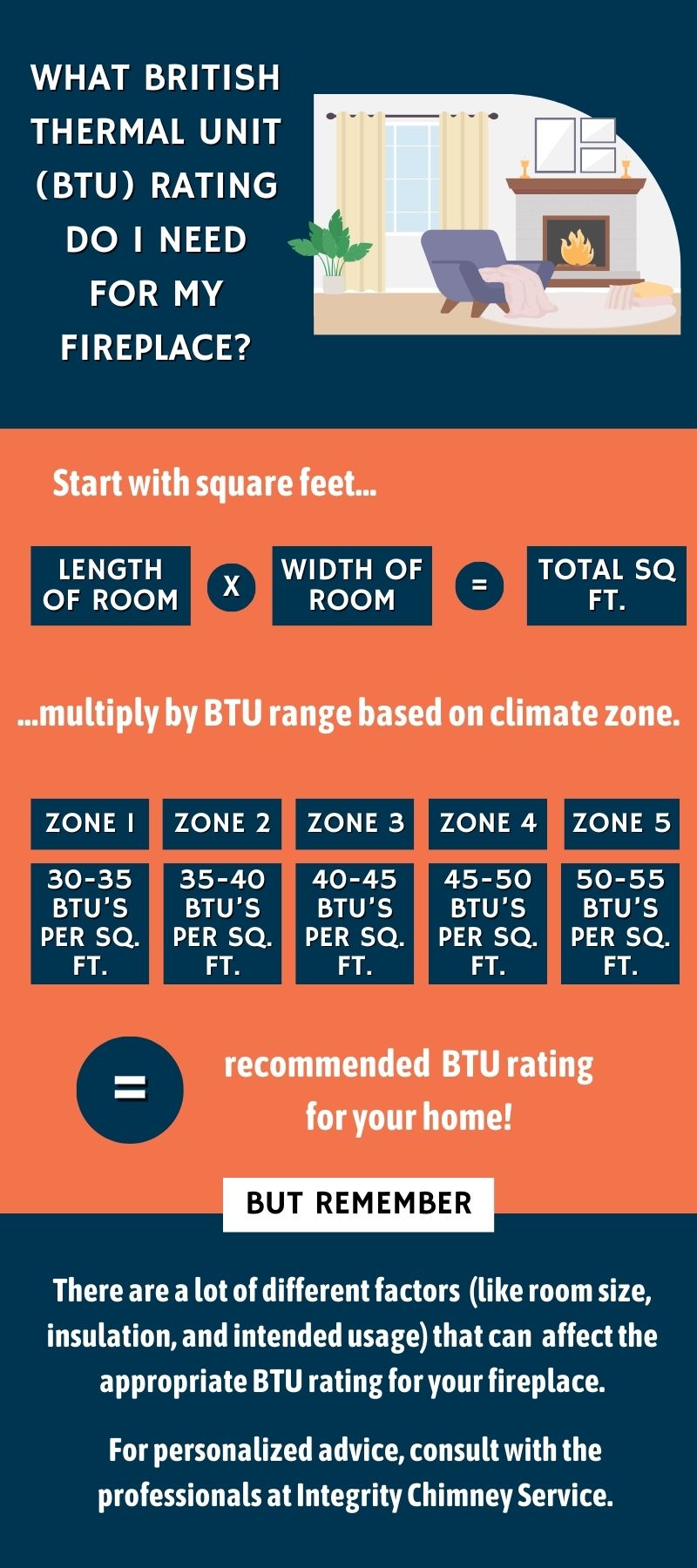When it comes to quantifying heat output on a furnace, heater, or fireplace insert, the standard for calculating thermal energy is measured with something called British Thermal Units (BTUs). …and if you’re like most people, you’re probably scratching your head, wondering just what that is exactly.
…it provides a standardized way to gauge the heating capacity of different appliances.
A British Thermal Unit is the measurement heating appliances use to quantify the amount of heat needed to raise the temperature of one pound of water by one degree Fahrenheit. Or in more practical terms, it provides a standardized way to gauge the heating capacity of different appliances. The higher the BTUs, the greater the heat output.
With fireplaces, this comes in especially handy when comparing different fireplace log sets or gas inserts – because we want to make sure whatever you choose is capable of effectively heating your space!
Whether you’re envisioning cozy moments next to the fireplace or needing a supplemental heating source, Integrity Chimney is here to guide you through the selection process and offer a clearer understanding of what your options are. Any questions? Give us a call today at 570-221-4113 or reach out online. We’re happy to assist you in finding the fireplace or heating appliance that checks all of your boxes. With us, your comfort and satisfaction are our top priorities.
What’s the Best BTU Rating for a Fireplace?
Unfortunately, fireplaces aren’t one-size-fits-all. An appliance with a greater heating capacity does provide more warmth, but it’s important we balance the efficiency of the appliance with the outside factors that can (and do) influence its performance. Considerations such as the size of the room, the climate in your region, and even the insulation within your home play important roles in determining what is the best British Thermal Unit rating for your fireplace.
For starters, let’s look at the square footage. Small spaces, like a bedroom, home office, or dining room, could require an appliance in the range of 5,000 to 15,000 BTUs. Larger spaces or fireplaces being used as the primary heat source would need 15,000 to 30,000 – and even upwards of 50,000 – BTUs or more.
But lets say, for example, your house doesn’t have the best insulation, has multiple windows that make your home a little drafty, or your region’s climate demands more from your heating system to keep warm during the winter. In these cases, we can’t just suggest a range of numbers based on the square footage – we have to consider the external factors that influence heat retention too.
Remember, the ultimate goal is to strike a balance between comfort, efficiency, and cost. The last thing you want is a new gas insert or log set that is constantly running to keep up, causing faster wear and tear on your appliance and eating up your utility bills.
Tips on How to Choose the Right Fireplace Option for Your Home
If you’ve ever spent a few minutes searching the internet for fireplace options, then you likely already know what an overwhelming process it can be. With an abundance of styles to choose from, all the different types to look at, and lots of neat features to consider, navigating this process can become much more manageable when you start with your basic heating needs first. By focusing on the following key factors, you can streamline your search and be confident in your choice.

- Calculate Room Size: Measure the square footage of the room where you plan to install the fireplace. You can do this by measuring the length and width of the room, then multiplying those numbers.
- Consider Your Climate: Depending on the climate zone where you live, you can estimate the average BTUs needed by multiplying your square footage by the number range in your climate zone. The heating factor in BTUs per square foot for each zone is as follows:
- Zone 1: 30-35
- Zone 2: 35-40
- Zone 3: 40-45
- Zone 4: 45-50
- Zone 5: 50-55 (Where Lake Ariel, PA is located)
- Determine Heating Needs: Is your fireplace going to be your primary source of heat or a supplemental one? A higher BTU rating may be suggested for a primary heating source, while a smaller rating could suffice for supplemental heating.
- Evaluate Efficiency: Look for fireplaces with high efficiency ratings. A more efficient unit can help achieve the desired warmth with fewer BTUs, which then reduces your energy consumption – and your costs to keep things warm and toasty.
- Read Customer Reviews: Do you have friends or family that have recently gone through a similar process? Consult with them – or maybe you can read up on reviews from other homeowners who have similar heating needs. This can provide valuable insight into how different fireplaces actually perform.
- Budget Considerations: Don’t just consider the initial costs of buying and installing a new fireplace. You’ll also need to keep in mind any ongoing operating costs. Sometimes, a more efficient fireplace might have higher upfront costs, but could save you money in the long run by consuming less energy.
When in Doubt, Consult With a Professional
If you’re still uncertain about the best fireplace BTU rating for your home and living space, our certified technicians at Integrity Chimney can help. We understand that choosing the right fireplace involves a combination of factors, and we help homeowners just like you every day. Our experts have the knowledge and experience to assess your unique requirements and make only the best recommendations based on your specific needs.
Give Integrity Chimney a call today at 570-221-4113 and let us provide you with the guidance and expertise you need to make an informed decision. You can also reach out to us online.

Recent Comments